Published Jun 11, 2021
Extreme Risk: B’Elanna Torres’ Journey Through the Looking Glass
B'Elanna's struggles with mental health can show us how to best face our own inner demons
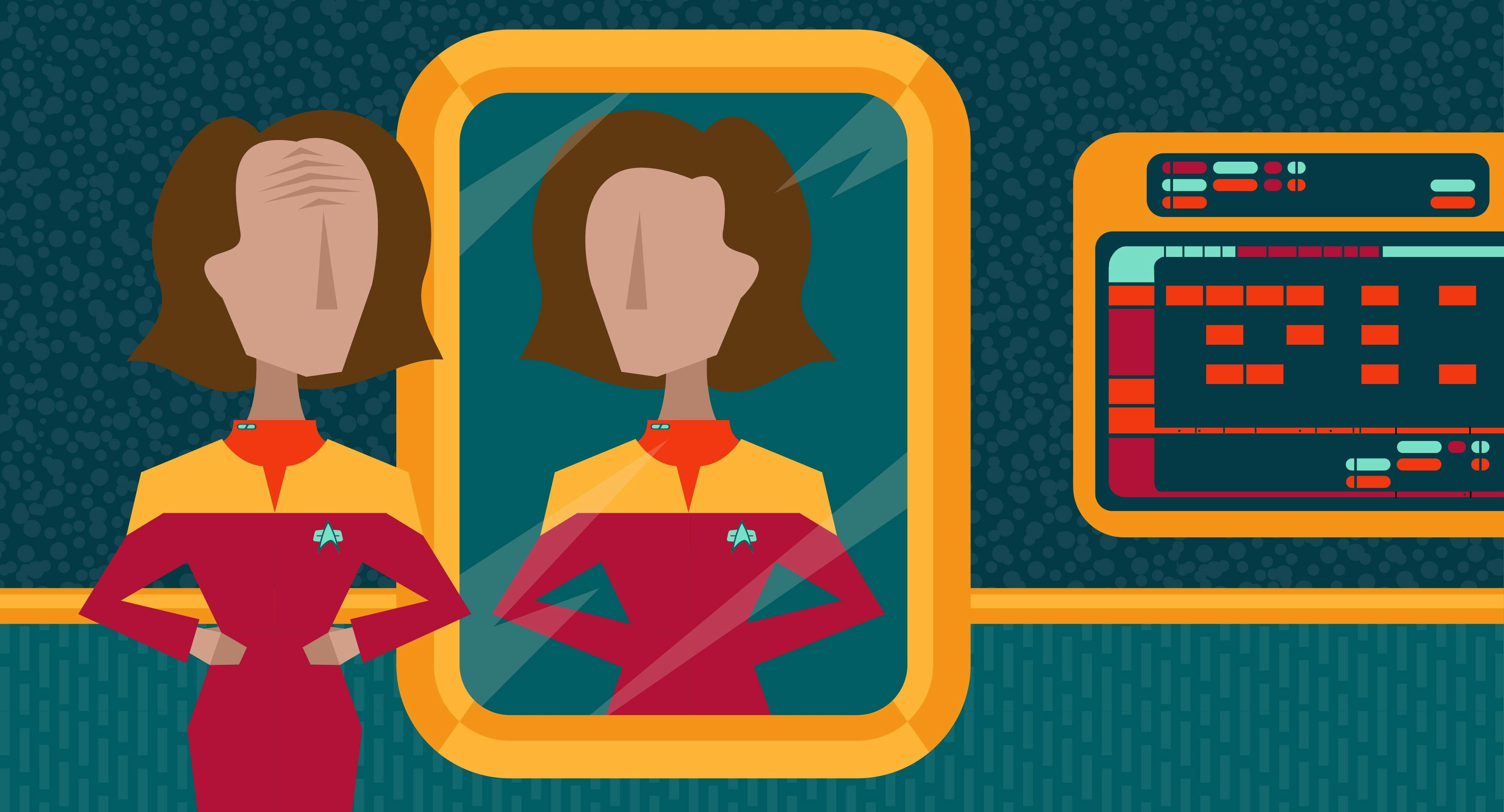
StarTrek.com
CW: This article explicitly discusses self-harm, depression, and suicidal ideation.
I’m a long-time Star Trek fan. I’m also a firm believer in the value of parasocial relationships and how our connection with fictional characters can be a catalyst for personal (and social) change. Thus, during the ongoing COVID-19 pandemic, I’ve found solace by having a cup of coffee (black) with some old friends in the mess halls of starships. Mainly, I returned to Star Trek: Voyager because, as we say in my home, it’s leadership porn, and that vision of a utopian future is something my family clings to as contemporary society continues to leave more people behind.
Voyager kept me alive through this callous time because, during my most recent re-watch of the series, something unexpected happened: seven people who worked with me died from the coronavirus, and it was devastating. Thus, despite the astounding number of amazing women on the series, including Star Trek’s first female captain, Captain Kathryn Janeway, an often misunderstood and under-appreciated character spoke to me more, Chief Engineer B’Elanna Torres, during my most recent re-watch. B’Elanna showed me that my current (and past) trauma doesn’t have to define me.
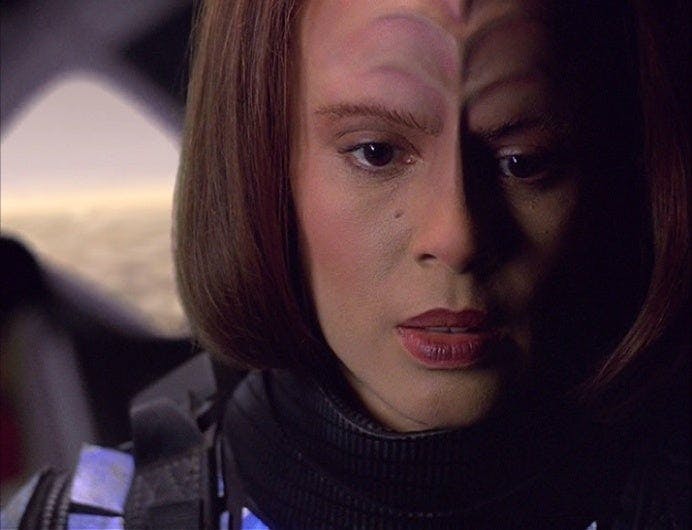
StarTrek.com
After the devastating loss of my co-workers, my old self-injurious and suicidal behaviors came back with a vengeance, connecting me to B’Elanna more than ever, especially in the Voyager episode “Extreme Risk.” That episode tells the story of her struggle with depression and self-harm after her Maquis friends’ deaths. Although I’ve related to various characters and stories before, this time through, B’Elanna spoke to me intimately, showing me that a person can succeed even when their mind and body want to work against them (albeit the success may be somewhat messy at times).
As an essential food and beverage worker and trauma survivor, it’s been tough to watch my co-workers die with little social support from the company that employed me. My co-workers brought magic to work each day, and now, that magic will have to carry on with me. I also feel compelled to help tell the untold story of essential workers at the front lines of this public health war – only my friend working with the homeless population has lost as many people to COVID-19 as me – and all the hospitality pixie dust that we cannot bring back from the grave. Was all the death worth it for a few hours of fun? Let’s all watch Voyager instead!
---
When Voyager first aired in 1995, I was a young individual exploring my gender and sexuality, as well as my inner golem. I mostly admired Captain Janeway for her steadfast commitment to her ideals, both scientific and philosophical, and had a “do-be” thing (a term my partner coined when you can’t decide whether you want to “do” or “be” someone) with Seven of Nine. But, when I returned to Voyager in 2020, my perception of the series was colored by the ongoing pandemic, and my new favorite character became B’Elanna, a feeling cemented by the fifth season episode “Extreme Risk,” in which she becomes depressed and engages in self-harm, isolating herself from others.
I know the B’Elanna in “Extreme Risk” because she is me: not knowing where you fit in as a queer patrilineal, not being able to talk about your emotions, or ask for help. Like B’Elanna, I even tried to stitch up my wounds, having the same conversation with my doctor about trying to hide it (although it’s important to know how to look after injuries for people who self-harm, it’s also essential to get proper medical attention as quickly as possible).
The episode “Extreme Risk” introduces B’Elanna’s self-injurious behaviors, but her harmful coping mechanisms are a habit she clings to throughout the show’s seven seasons, beginning in the first season. In “Faces,” B’Elanna is split into two separate beings – one is her entirely Klingon self, and one is her fully Human self – and it serves as an essential introduction to B’Elanna’s psychological turmoil and inner conflict.
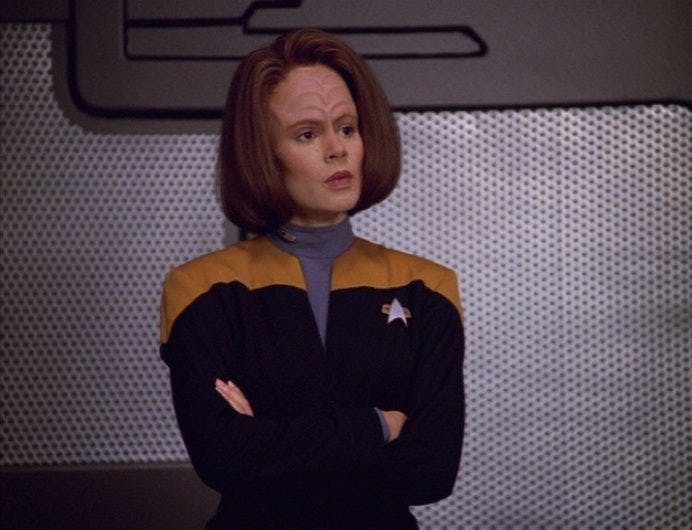
StarTrek.com
B’Elanna sees herself as two halves at war: Klingon B’Elanna is aggressive and reactive, and she’s the opposite of Human B’Elanna, who is cowardly and nervous. Although B’Elanna gains confidence in her abilities throughout the first few seasons, she even seems happy for a time, bonding with the other senior staff and building a family, after learning that the Cardassians massacred the Maquis, she falls into another major depressive episode and starts to self-harm.
In reaction to the news (which fans first learned about in Star Trek: Deep Space Nine in 1997 and the fourth season Voyager episode “Hunters” in February 1998) B’Elanna stops feeling any emotion and starts to run holodeck programs without the safety protocols to feel “alive.” Although she recovers, it’s not the end of her journey to manage her mood disorder. When B’Elanna learns that her daughter will have the same Klingon facial ridges she has, it causes her to have flashbacks to traumatic childhood memories and throws her into a psychotic state. In “Lineage,” she lies to loved ones about her traumatic flashbacks and tampers with the Doctor’s holo-matrix so that he will perform an operation that puts her and her unborn child at risk. The episode shows that B’Elanna’s mental health issues didn’t just go away, showing how suicidality and self-harm can persist throughout life, even following a successful intervention.
Mental illness doesn’t always disappear, especially not with a single intervention. Instead, treatment requires openness and self-care and help to manage challenging emotions. B’Elanna helped teach me that suicidality isn’t a weakness, and it’s something that people can overcome with help.
Roxann Dawson presents viewers with a nuanced exploration of self-harm, which makes it no surprise to learn that she championed the topic’s inclusion in the series. Plus, Dawson’s outstanding performance spoke to many viewers, and it’s no wonder because she nails every expression – from her flat speech to her indifference to her defensiveness when questioned by her family. But, while I’ve read more than one account of the episode’s emotional impact, none of them reflect on self-harm as a behavior distinct from the depression, missing a significant opportunity to discuss the positive impact of the episode on the more considerable discussion surrounding stigma and mental health.
It’s difficult for people who self-harm to openly discuss their struggles because of the stigma surrounding the behavior – because, even in the context of psychological disorders, it’s difficult to understand how someone can purposefully hurt their own body. However, it’s just another unhealthy and potentially self-destructive coping mechanism (like drinking or overeating) used by humans to distract themselves from emotional distress. For people like me, self-harm is another way to deal with problems or strong feelings. Therefore, to replace self-injury with alternative behaviors, it’s essential to understand the specific context in which the self-injury develops – and that’s where fictional stories and parasocial interactions come in.
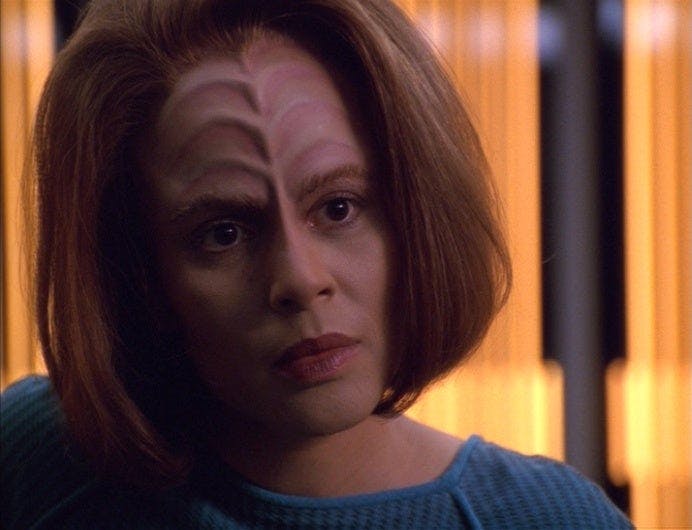
StarTrek.com
Fictional stories model how people ideally behave in a situation giving us a model of how a person and their loved ones can respond to a mental health crisis. In “Extreme Risk,” B’Elanna’s war with herself takes on a destructive tone, making it an apt metaphor for real reaction to trauma and loss. After she disengages the safety protocols on a holodeck shuttle simulation, microfractures in the shuttle knock her unconscious. Although this self-harm method is purely science fiction, it’s still a helpful metaphor for understanding self-harm. Once B’Elanna enters treatment, the Doctor finds old wounds that went untreated, and he must treat her depression so that she stops eagerly trying to put herself in an early grave. B’Elanna’s behavior and the Doctor’s response resonated with me, reminding me that people do care.
---
In genuine Star Trek role-modeling, the Voyager crew must intervene to help B’Elanna cope with grief, and they respond well to her mental health crisis. With her friends’ help and a well-timed engineering project, she’s able to start healing from the grief of loss. Although it’s somewhat unrealistic that a resolution would happen so quickly, it’s helpful for people to see how to deal with a mental health crisis appropriately. In this case, Tom Paris already knows to give her space, Neelix is ready to listen over a stack of banana pancakes, and then, after Chakotay finds B’Elanna nearly dead on the holodeck, she’s involuntarily committed to sickbay because she presents a danger to herself.
At the height of a depressive episode, it’s vital to get creative when seeking support, and that’s the role B’Elanna and the Voyager crew played for me. After all, when my life feels like another person’s movie, it isn’t easy to reach me by traditional human connection methods. “Extreme Risk” is an excellent example of Star Trek portraying mental health issues that depict a positive future where illness is understood and the people around the person always help. Although B’Elanna makes a lot of progress in under a day (an unrealistically speedy turnaround) it’s nice to see people respond to a mental health crisis appropriately and to see a person taking pleasure in self-care to maintain psychological well-being (e.g., eating banana pancakes). Although it’s not so simple to love and support someone through depression and suicidal ideation in real life, it’s still important to see on screen – and hopefully, more therapists will take the time, patience, and empathy to speak the patient’s language.
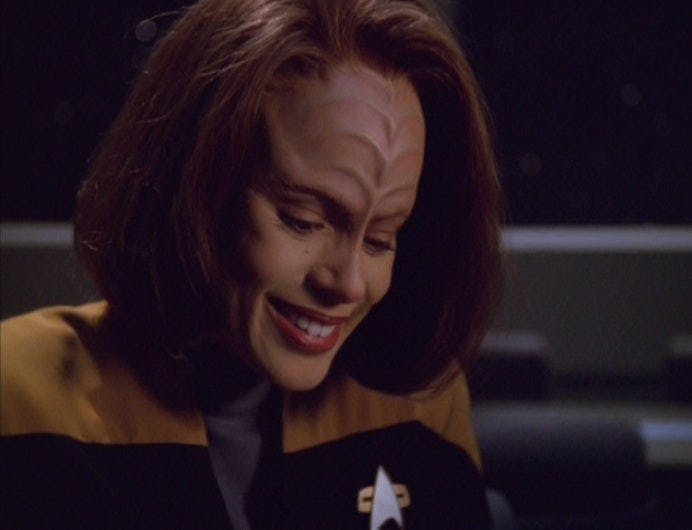
StarTrek.com
---
Fandoms, therapists, and loved ones can work together to break down stigmas and be there for people struggling with mental illness. If you currently self-harm and want to learn how to feel better without hurting yourself, go to the CRISIS TEXT LINE.
Rebecca Kaplan (she/her) has a Master of Science in Criminology and Juris Doctor. To the disappointment of her law school, she’s really a geek at heart and would rather have a cup of coffee with Captain Janeway than any non-fiction person. You can find her writing at Marvel Blog and in Double Challenge: Being LGBTQ and a Minority, which she co-authored with her wife, Avery Kaplan. Find her at @RebeccaKaplan6

